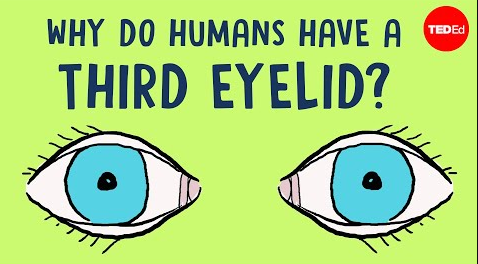You know that little pink thing nestled in the corner of your eye? It's actually the remnant of a third eyelid.
你知道缩在你眼角中粉色小东西吗?这实际上是第三层眼皮的残余。
Known as the "plica semilunaris," it's much more prominent in birds and a few mammals,
被称为“半月皱襞”,它在鸟类和一些哺乳动物中更明显,
and functions like a windshield wiper to keep dust and debris out of their eyes.
功能就像挡风玻璃上的雨刷器,防止灰尘和小碎片进入眼睛。
But in humans, it doesn't work. It's vestigial, meaning it no longer serves its original purpose.
而对于人类,它却没有什么用。它退化了,意味着起不到原有作用了。
There are several other vestigial structures like the plica semilunaris in the human body.
像半月皱襞一样,还有其它一些退化结构的残余存在于人体中。
Most of these became vestigial long before homo sapiens existed, quietly riding along from one of our ancestor species to the next.
多数在智人存在之前就已经退化了,安静地随着我们祖先一步步进化。
But why have they stuck around for so long?
但为什么半月皱襞能存在如此之久?
To answer this question, it helps to understand natural selection.
为了回答这个问题,理解自然选择会有所帮助。
Natural selection simply means that traits which help an organism survive
自然选择意味着有助于一种生物体存在的,
and reproduce in a given environment are more likely to make it to the next generation.
并在给定环境中能够复制的特征更可能会传递给下一代。
As the environment changes, traits that were once useful can become harmful.
当环境改变时,曾经有用的特征可能会变得有害。
Those traits are often selected against, meaning they gradually disappear from the population.
这些特征经常会被选择性淘汰,意味着从种群中逐渐消失。
But if a trait isn't actively harmful, it might not get selected against, and stick around even though it isn't useful.
但如果某一特征没有实际坏处,则可能不会被淘汰,即使没用也会保留下来。
Take the tailbone. Evolutionary biologists think that as the climate got drier and grasslands popped up,
想想尾锥。进化生物学家认为,随着气候的干燥,草原的出现,
our tail-bearing ancestors left the trees and started walking on land.
我们长有尾巴的祖先离开树林,并开始在地面上行走。
The tails that had helped them in the trees began to disrupt their ability to walk on land.
在树林中辅助他们的尾巴影响了它们在地上的行走能力。
So individuals with mutations that reduced the length of their tails became more successful at life on land,
因突变而具有缩短尾巴长度的个体在地面生活中变得更成功,
surviving long enough to pass their short tails on to the next generation.
它们的生存时间足够长,得以将短尾巴的特征传给下一代。
The change was likely gradual over millions of years until, about 20 million years ago, our ancestors' external tails disappeared altogether.
在上百万年的时间中,变化是渐进的,直到大约2000万年前,我们祖先的外部尾巴完全消失了。
Today, we know human embryos have tails that dissolve as the embryo develops.
今天,我们知道人类胚胎仍然长有尾巴,它会随着胚胎发育,逐渐消失。
But the stubby tailbone sticks around, probably because it doesn't cause any harm
但短短的尾锥保留了下来,可能因为没有什么坏处,
in fact, it serves a more minor function as the anchor point for certain other muscles.
实际上,尾椎对固定某些肌肉仅有一点点什么作用。
Up to 85% of people have a vestigial muscle called the "palmaris longus."
超过85%的人都具有一种退化残余称为“掌长肌”的肌肉。

To see if you do, put your hand down on a flat surface and touch your pinkie to your thumb.
看看你是否也有,把你的手放在一个平面上,用小指触摸大拇指。
If you see a little band pop up in the middle of your wrist, that's the tendon that attaches to this now-defunct muscle.
如果看到手腕中部突起一小条肌肉,这就是连接到这条退化肌肉上的肌腱。
In this case, the fact that not everyone has it has helped us trace its function.
这种情况下,不是每个人都有这条肌肉的事实能够帮助我们跟踪其功能。
Vestigial traits can persist when there's no incentive to lose them
退化的残余特征即使倘若没有理由消失,便可能会保留下来,
but since there's also no incentive to keep them, random mutations will sometimes still eliminate them from part of the population.
但由于也没有什么理由保留它们,随机的突变,有时也会促使其从部分种群中消失。
Looking at our primate relatives, we can see that the palmaris longus is sometimes absent in those that spend more time on the land,
看看我们的灵长目亲戚,我们可以看到,那些更多时间于地面生活的物种,有的掌长肌消失了,
but always present in those that spend more time in trees.
但在更多时间于树上生活的物种中,它通常得以保留。
So we think it used to help us swing from branch to branch, and became unnecessary when we moved down to land.
所以我们认为掌长肌能帮助我们在树枝间摇荡,当我们搬到地面上生活时,它就变得不那么必要了。
The appendix, meanwhile, may once have been part of the intestinal system our ancestors used for digesting plant materials.
同时,阑尾可能曾经是我们的祖先用于消化植物的内部系统器官之一。
As their diets changed, those parts of the intestinal system began to shrink.
当它们的日常饮食改变时,那些内部系统的开始部分萎缩。
Unlike other vestigial structures, though, the appendix isn't always harmless -- it can become dangerously inflamed.
然而不像其他退化的残余结构,阑尾并不总是无害的--它可能会因发炎而变得危险。
For most of human history, a burst appendix could be a death sentence. So why did it stick around?
在人类大部分历史中,急性阑尾炎可能是致命的。那它为什么会保留下来?
It's possible that it was very slowly on its way out, or that mutations simply hadn't arisen to make it smaller.
可能其消失过程非常缓慢,或者只是使它变小的突变还没有出现。
Or maybe it has other benefits -- for example, it might still be a reservoir of bacteria that helps us break down food.
再或者可能还有其他的好处--例如,阑尾可能是一个容器,容纳细菌来帮助分解食物。
But the fact is, we're not really sure why the appendix persists. Evolution is an imperfect process.
但实际上,我们并不确定阑尾为什么存在。进化是一个不完美的过程。
Human beings are the result of millions of years of trial, error, and random chance
人类是上百万年试验、错误、随机的产物,
and we're full of evolutionary relics to remind us of that.
有好多的进化残余提醒着我们这一点。













